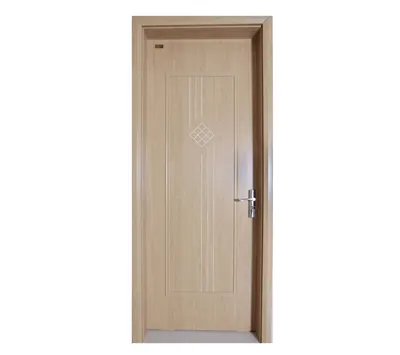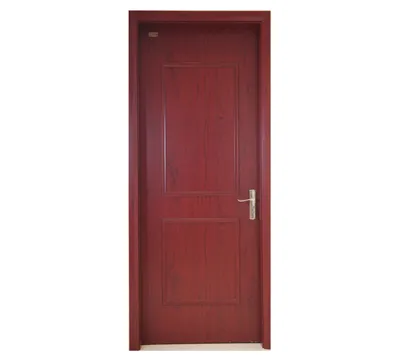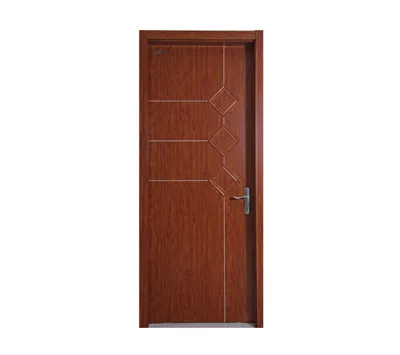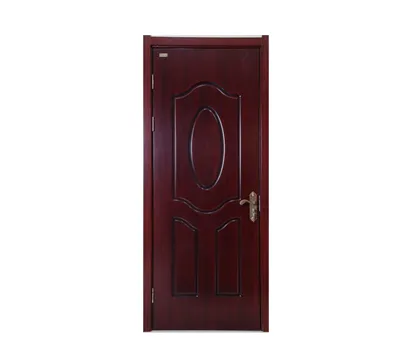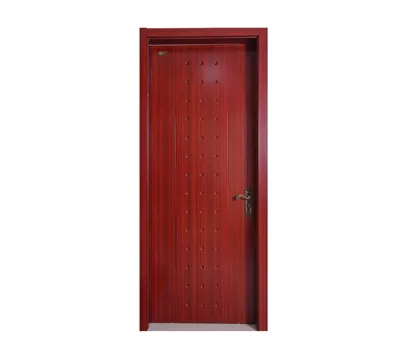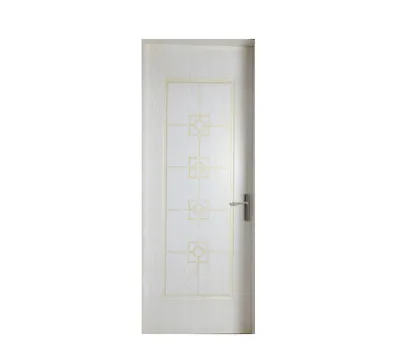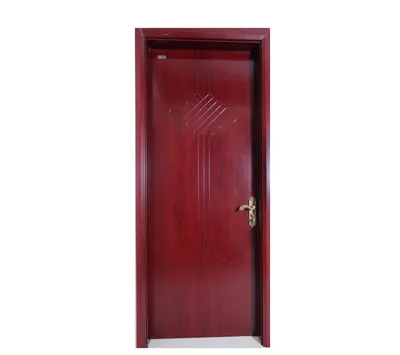
Wood-plastic composite doors are manufactured through molding technology using a blend of ultra-fine wood particles and polymer resin, combining the superior properties of both wood and plastic. The resulting products achieve an authentic wood-like appearance. Since the production process eliminates adhesive use, they do not emit harmful substances like formaldehyde, benzene, ammonia, or trichloroethylene, making them an eco-friendly alternative to traditional wood. [Composition of raw materials for wood-plastic doors] The primary raw materials for wood-plastic composite (WPC) doors are PVC resin and **wood powder. The PVC resin uses medical-grade domestic **material, while the wood powder is sourced from specialized wood companies containing **species wood powder. Through processes including grading, screening, grinding, drying, and coating treatment, the finished product meets strict quality standards. The WPC door formulation system incorporates auxiliary materials in specific proportions, along with stabilizers, foaming agents, and modifiers. These components are precisely mixed according to strict ratios to ensure optimal quality of the foam board products. [Features of production equipment] The advanced production equipment, including both the mixing system and extrusion system, was fully imported from overseas, achieving international **standards with high automation. The mixing equipment features precise dosage control, uniform blending, and high efficiency, fundamentally ensuring product stability. Given the stringent requirements for foaming extrusion equipment in wood-plastic foam door manufacturing, we adopted a high-torque twin-screw extruder and modified components such as screws and barrels. This adaptation addresses surface scaling and uniform foaming issues while preventing wood powder carbonization. [Surface treatment] Heat Transfer Technology** utilizes thermal transfer technology to imprint various patterns onto extruded panels, enabling products to showcase diverse** wood grain textures and color variations. In response to current market trends, we have designed multiple decorative finishes including black walnut, ivory white, and wax oak for customers 'selection. Additionally, we provide over fifty interior door design options to meet modern consumers' personalized lifestyle demands. merit 1. The wood-plastic door formula system is equipped with a certain proportion of auxiliary materials, such as stabilizer, foaming agent, modifier, etc. All components are mixed in strict proportion to effectively ensure the product quality of foamed board. 2. Wood-plastic composite doors deliver exceptional durability with a wood-like appearance. Featuring superior hardness and rigidity compared to conventional plastic products, they exhibit excellent physical properties including dimensional stability that outperforms natural timber. These doors resist cracking, warping, and common defects like knots, grain lines, or diagonal cracks. Furthermore, they maintain the reworking flexibility of wooden doors, allowing versatile applications such as sawing, planing, bonding, and secure fastening with nails or screws. 3. Excellent Flame Retardant Performance: The wood-plastic composite (WPC) doors in the set do not support combustion when exposed to open flames and will automatically extinguish after ignition. Test results show that Guoqiang's WPC doors have an oxygen index of 48, achieving a fire resistance rating of Class B1. This performance significantly enhances the fire safety of residential homes. 4. Surface treatment technology is diverse, such as heat transfer, peritoneum or baked paint. According to the customer's own needs, a variety of gorgeous appearance can be made, and the stability is high and the life is long. 5. The wood-plastic composite door features a rational structural design and exceptional strength. Its unique cavity structure ensures optimal internal configuration for the foam material, combined with advanced formulation and precision manufacturing processes to guarantee durability. The quick-installation system incorporates Germany-introduced technology, making door frame assembly exceptionally convenient. The frame connectors utilize snap-fit joints eliminating the need for nails or adhesive, achieving time-saving and labor-efficient installation. characteristic 1. The raw materials for wood-plastic composite doors are formed in one-step molding under high temperature, high pressure, and vacuum conditions. The materials are formaldehyde-free, and during secondary processing, heat transfer printing technology is employed to eliminate the need for painting. Throughout production and use, there is no release of toxic gases or odors, making it a human-friendly product that meets modern indoor decoration environmental standards. 2. Waterproof, moisture-resistant, anti-corrosive, mold-resistant, insect-proof, and dimensional-stable: Wood-plastic composite (WPC) products combine the dual strengths of wood and plastic. Therefore, WPC sliding doors are not only suitable for indoor exterior applications but also particularly recommended for environments with significant temperature fluctuations, high humidity, and poor ventilation – such as humid bathrooms or storage rooms requiring corrosion resistance, mold prevention, and pest protection. 3. Excellent Thermal Insulation and Soundproofing Performance The wood-plastic composite door set utilizes materials with uniform, fine-cell foam structures and specially designed cavity configurations. These features ensure lower thermal conductivity than conventional plastic materials while delivering superior noise reduction capabilities. Testing results indicate the product achieves a heat transfer coefficient of 1W/m2.k, meeting China's GB/T 16729-1997 standard with Class I thermal insulation performance. Its Class 6 sound insulation rating further demonstrates outstanding thermal and acoustic containment properties. For more information about plastic doors, please call us.

Wood-plastic composite doors are manufactured through molding technology using a blend of ultra-fine wood particles and polymer resin, combining the superior properties of both wood and plastic. The resulting products achieve an authentic wood-like appearance. Since the production process eliminates adhesive use, they do not emit harmful substances like formaldehyde, benzene, ammonia, or trichloroethylene, making them an eco-friendly alternative to traditional wood. [Composition of raw materials for wood-plastic doors] The primary raw materials for wood-plastic composite (WPC) doors are PVC resin and **wood powder. The PVC resin uses medical-grade domestic **material, while the wood powder is sourced from specialized wood companies containing **species wood powder. Through processes including grading, screening, grinding, drying, and coating treatment, the finished product meets strict quality standards. The WPC door formulation system incorporates auxiliary materials in specific proportions, along with stabilizers, foaming agents, and modifiers. These components are precisely mixed according to strict ratios to ensure optimal quality of the foam board products. [Features of production equipment] The advanced production equipment, including both the mixing system and extrusion system, was fully imported from overseas, achieving international **standards with high automation. The mixing equipment features precise dosage control, uniform blending, and high efficiency, fundamentally ensuring product stability. Given the stringent requirements for foaming extrusion equipment in wood-plastic foam door manufacturing, we adopted a high-torque twin-screw extruder and modified components such as screws and barrels. This adaptation addresses surface scaling and uniform foaming issues while preventing wood powder carbonization. [Surface treatment] Heat Transfer Technology** utilizes thermal transfer technology to imprint various patterns onto extruded panels, enabling products to showcase diverse** wood grain textures and color variations. In response to current market trends, we have designed multiple decorative finishes including black walnut, ivory white, and wax oak for customers 'selection. Additionally, we provide over fifty interior door design options to meet modern consumers' personalized lifestyle demands. merit 1. The wood-plastic door formula system is equipped with a certain proportion of auxiliary materials, such as stabilizer, foaming agent, modifier, etc. All components are mixed in strict proportion to effectively ensure the product quality of foamed board. 2. Wood-plastic composite doors deliver exceptional durability with a wood-like appearance. Featuring superior hardness and rigidity compared to conventional plastic products, they exhibit excellent physical properties including dimensional stability that outperforms natural timber. These doors resist cracking, warping, and common defects like knots, grain lines, or diagonal cracks. Furthermore, they maintain the reworking flexibility of wooden doors, allowing versatile applications such as sawing, planing, bonding, and secure fastening with nails or screws. 3. Excellent Flame Retardant Performance: The wood-plastic composite (WPC) doors in the set do not support combustion when exposed to open flames and will automatically extinguish after ignition. Test results show that Guoqiang's WPC doors have an oxygen index of 48, achieving a fire resistance rating of Class B1. This performance significantly enhances the fire safety of residential homes. 4. Surface treatment technology is diverse, such as heat transfer, peritoneum or baked paint. According to the customer's own needs, a variety of gorgeous appearance can be made, and the stability is high and the life is long. 5. The wood-plastic composite door features a rational structural design and exceptional strength. Its unique cavity structure ensures optimal internal configuration for the foam material, combined with advanced formulation and precision manufacturing processes to guarantee durability. The quick-installation system incorporates Germany-introduced technology, making door frame assembly exceptionally convenient. The frame connectors utilize snap-fit joints eliminating the need for nails or adhesive, achieving time-saving and labor-efficient installation. characteristic 1. The raw materials for wood-plastic composite doors are formed in one-step molding under high temperature, high pressure, and vacuum conditions. The materials are formaldehyde-free, and during secondary processing, heat transfer printing technology is employed to eliminate the need for painting. Throughout production and use, there is no release of toxic gases or odors, making it a human-friendly product that meets modern indoor decoration environmental standards. 2. Waterproof, moisture-resistant, anti-corrosive, mold-resistant, insect-proof, and dimensional-stable: Wood-plastic composite (WPC) products combine the dual strengths of wood and plastic. Therefore, WPC sliding doors are not only suitable for indoor exterior applications but also particularly recommended for environments with significant temperature fluctuations, high humidity, and poor ventilation – such as humid bathrooms or storage rooms requiring corrosion resistance, mold prevention, and pest protection. 3. Excellent Thermal Insulation and Soundproofing Performance The wood-plastic composite door set utilizes materials with uniform, fine-cell foam structures and specially designed cavity configurations. These features ensure lower thermal conductivity than conventional plastic materials while delivering superior noise reduction capabilities. Testing results indicate the product achieves a heat transfer coefficient of 1W/m2.k, meeting China's GB/T 16729-1997 standard with Class I thermal insulation performance. Its Class 6 sound insulation rating further demonstrates outstanding thermal and acoustic containment properties. For more information about plastic doors, please call us.
